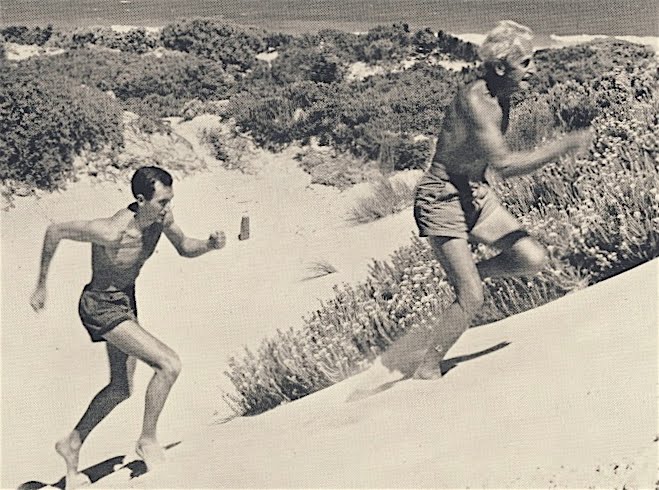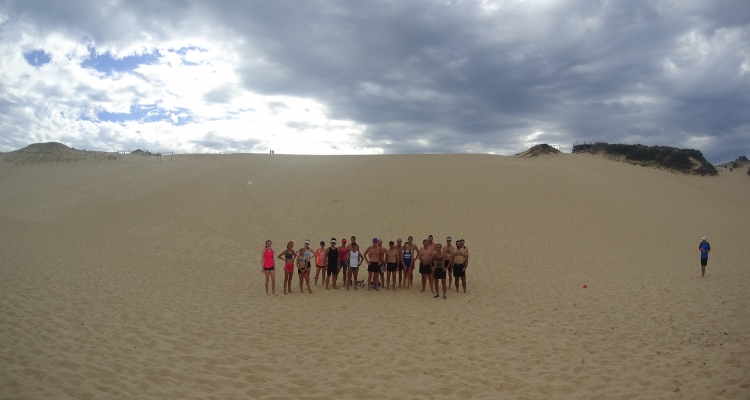Prepare for you upcoming racing season with some quality sessions on sandhills.
Article written by well known Australian running coach Sean Williams of MelbournePack
Resistance training for runners comes in many forms. My favourite would have to be Sandhill running. We have had close to 100 training camps over the last few decades. Many of these camps have include Sandhill running sessions. The upcoming 2017 MELBOURNE PACK running camp at Phillip Island will include a Sandhill session. Our sister group in Sydney, SWEAT SYDNEY, include regular Sandhill sessions at Wanda Beach in their program.
Running up inclines in soft sand is hard work and beneficial strength and technique for running not only in hilly road, cross country, and trail races, but even for flat races. The arm action is far more vigorous than for any other style of running. A much higher foot lift/knee lift is essential when running up a Sandhill.
The most testing form of hill running is up steep Sandhills, which requires exaggerated running movements. Lifting the feet high out of the sand and thus forcing the knees upwards and pumping the arms super hard is extremely tiring. It is perhaps the most surefire way to elevate the heart rate. It seeks out weaknesses all over the body. If a runner remains perpendicular to the hill being run up, the glut muscles will be working overtime. The calves, quads, hip flexors and Achilles are also sure to get an amazing workout.
A huge bonus of training on Sandhills as opposed to hills on trails or the road is that runners should generally recover much faster from a Sandhills session. This is due to the low impact on the body that soft sand has.
Perhaps the greatest beauty of training on Sandhills is the fact that they are positioned in areas with breathtaking scenery. The beauty of the natural surrounds will be enough to take your breath away, let along the extremity of the actual workout! The fact that one can jump in the ocean to cool off after a workout for a sweet, rewarding recovery is a bonus.
Some of the greatest track runners in history included regular gut wrenching Sandhill training to their schedules, including Herb Elliot and Steve Ovett. Thus Sandhill training has proven to benefit those preparing for FLAT races. It obvious that Sandhill training will greatly benefit runners preparing for hilly races on road, cross country and trails. Thus if you are preparing for some of these races, and have access to Sandhills for training, I recommend you HIT THOSE DUNES.

Here is a list of awesome Aussie races with plenty of hills.
• Two Bays Trail Run: http://www.twobaystrailrun.com/
• Rollercoaster Run: http://www.rollercoasterrun.com/wp/
• Baw Baw Trail Run Festival: http://runningwild.net.au/alpine-runs/mt-baw-baw-trail-fest-1-3-12-21-42-km.html
• Sydney Trail Run Series: http://www.sydneytrailseries.com.au/sydneytrailseries/manly
• Running Wild trail races: http://www.runningwildnsw.com/about/
• Sun Run- Dee Why to Manly: http://sunruncoleclassic.com.au/
• The Six Foot Track Marathon: http://www.sixfoot.com/
• The Great Volcanic Mountain Challenge, Orange: http://www.greatvolcanic.org/
• Jabulani Challenge: http://jabulanichallenge.com.au/
• Razorback Run: http://runningwild.net.au/alpine-runs/razorback-run.html
• Buffalo Stampede: http://www.buffalostampede.com.au/
• Mt Buller SkyRun: http://runningwild.net.au/alpine-runs/mt-buller-sky-run.html
• Puffing Billy Great Train Race: http://puffingbilly.com.au/en/events-and-dining/gtr/
• Wilson’s Prom 100: http://runningwild.net.au/coastal-runs/wilsons-prom-100.html
• Ultra Trail Australia 22km, 50km, 100km: http://www.ultratrailaustralia.com.au/
• Great Ocean Road Running Festival: http://greatoceanroadrunfest.com.au/
• Balmoral Burn: http://www.humpty.com.au/our-events/balmoral-burn/
• Glow Worm Tunnel Trail Marathon Weekend: http://www.glowwormtrail.com/
• MiniMos 10km: http://www.mini-mos.com
• Balmain Fun Run: http://balmainfunrun.com.au/
• Hoka One One Trail Running Series: http://rapidascent.com.au/HokaOneOneTrailSeries/
• Big Red Run: http://www.bigredrun.com.au/bigredrun/index
• Winery Running Festival: http://wineryrun.com/
• You Yangs Trail Running Festival: http://www.trailsplus.com.au/you-yangs/
• City to Surf: http://city2surf.com.au/
• Oxfam Trailwalker: https://trailwalker.oxfam.org.au/sydney/
• Bilpin Bush Run: http://www.bilpinbushrun.com.au/
• Wonderland Run Grampians: http://www.wonderlandrun.com.au/
• Pub to Pub (Dee Why to Newport): http://pub2pub.fusesport.com/
• Surf Coast Century: http://rapidascent.com.au/SurfcoastCentury/
• The Great North Walk 100s: http://www.terrigaltrotters.com.au/GNW100s.htm
• Great Ocean Walk Trail Run: https://sites.google.com/site/gow100s/home
• Juniors Maroubra Fun Run: http://maroubrafunrun.com.au/
• Carcoar Cup Running Festival: http://www.carcoarcup.com.au/
• Red Bull Dune Dusters: http://hevents.com.au/events/
• Portsea Twilight 8km: http://events.solemotive.com/portsea/event-information/
• Point to Pinnacle: http://www.pointtopinnacle.com.au/
• Yurrebilla Trail Ultra: http://www.y56k.com.au/
Runners are best off using correct form when running both uphill and downhill. This form should be practiced in both training and racing. It is very simple.
UPHILL RUNNING
When running uphill, regardless of the speed, runners must aim to keep as upright as possible. Another way of putting it is to ‘run tall’. The shoulders should be tucked back and chest out. The main reason for keeping the torso as upright as possible when running uphill is so the gluts and upper quads are used, not just the lower quads and calves. If a runner leans forward into an uphill they will only use their calves and lower quads with any decent power. The gluts and upper quads are very powerful and a runner should really try to put them to good use by keeping tall. Of course, the lower quads and calves will still be used.
The feet should lift immediately below the hips. When running fast they will lift higher and at a quicker tempo. It is best to land on the forefoot.
Use of arm drive when running uphill will depend on the speed of a runner. For someone sprinting up a hill then big arm drive is crucial, with the hands coming forward to nose level and the elbows pumping back as far as possible. Keep the arms at approximately 90 degrees. For someone cruising up a hill in a longer race, the arms should keep as relaxed as possible. Feel the muscles hang off the bones as you swing the arms gently.
Running uphill is one of the best ways to elevate you heart rate. Many novices make the mistake of allowing their breathing to get out of control when running uphill. In the early stages of an uphill it is best to keep your breathing rate at one breath in for every steps taken and one breath out for every 3 steps taken. Once this becomes too hard, revert to taking one breath in for every two steps taken and one breath out for every two steps taken.
DOWNHILL RUNNING
Running downhill is very simple. Lean forward and let yourself move down the hill as quickly as possible, taking very light steps. By leaning forward your stride will lengthen and your leg speed will increase due to the gravity. Do not lean back. If you do that your quads will act as brakes and end up very sore mid-session or race.
Just as in uphill running, the feet should lift immediately below the hips. This will ensure you don’t over stride. Just as with correct body lean, it will guarantee your quads do not act as brakes. As in uphill running, It is best to land on the forefoot.
There are many different types of hill sessions, which can be touched upon another time.

